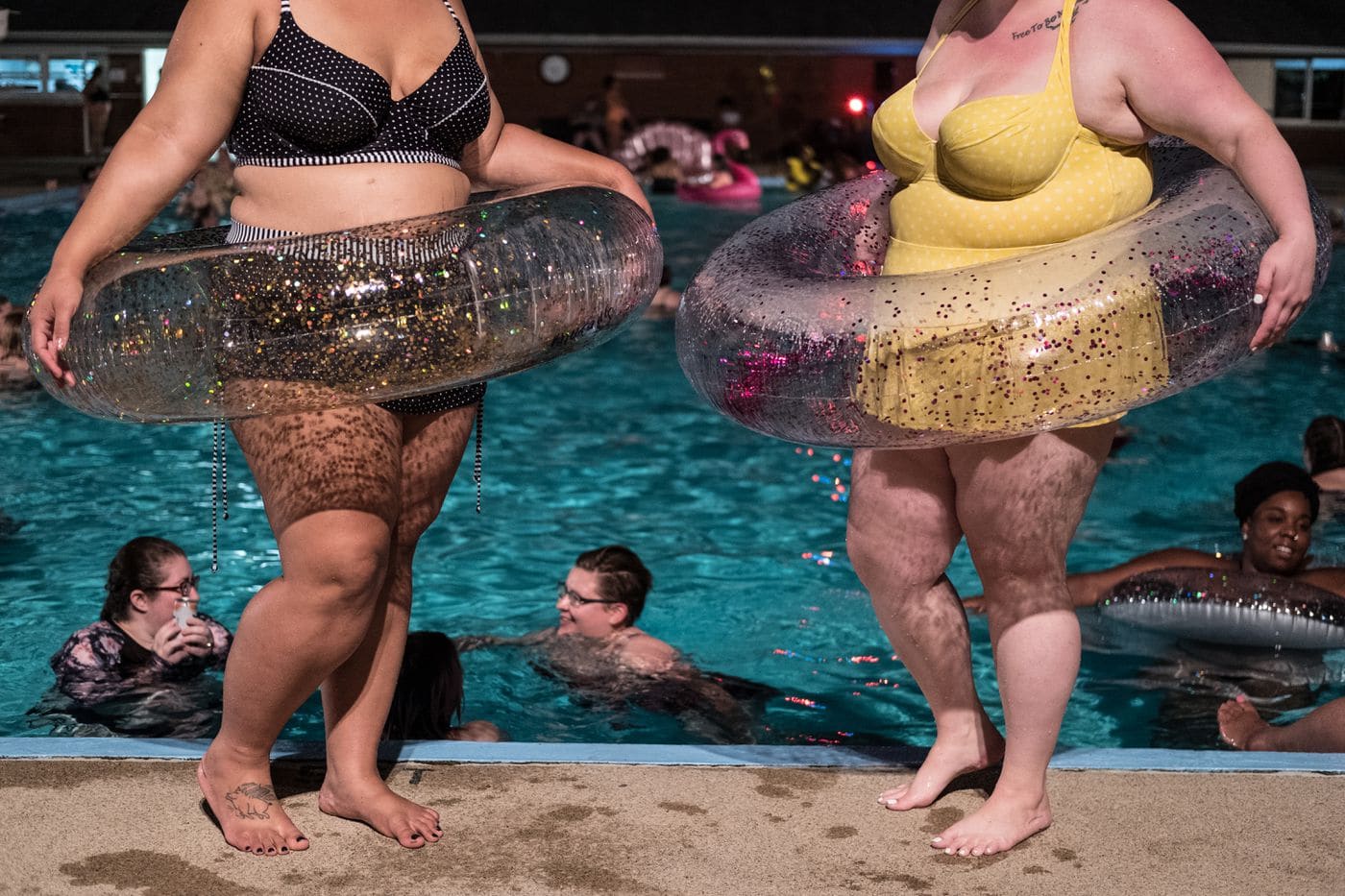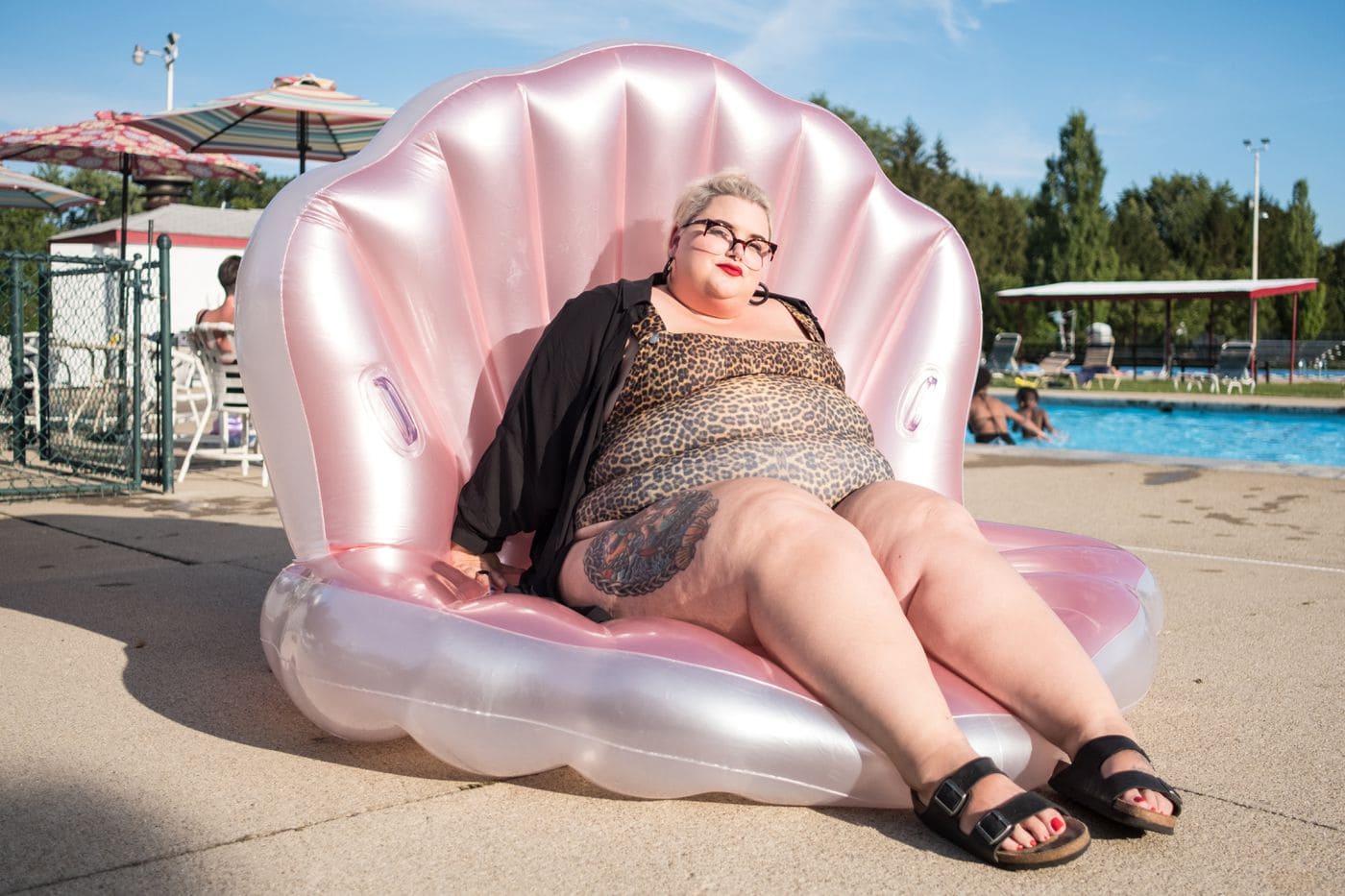Founders of the Fat Babes Club of Columbus at their Aug. 10 pool party. (Megan Jelinger for The Lily)
COLUMBUS, Ohio — Rachel Carpenter loves to swim. But until recently, she hadn’t been to a pool in six years.
The 21-year-old says she used to feel stares and judgment when she stripped off her cover-up and jumped into the water, so she opted to avoid the experience altogether.
But as the sun set over the Westerville Jaycee Community Pool in Columbus on Aug. 10, Carpenter didn’t feel ashamed. As kids headed home, the public pool transformed into a body-positive party — a place where Carpenter felt not only unashamed, but celebrated.
A few hours later, Carpenter would call the event “one of the best nights ever”:
The recent Saturday night party, put on by a group called Fat Babes Club of Columbus, featured a kaleidoscope of different sizes, shapes and gender identities. Attendees laughed, cheered and cannonballed into the pool, which was dotted with colorful pool floats. Flashing lights danced across the water; Lizzo tunes electrified the air.
Members of the Fat Babes Club of Columbus swim during their Aug. 10 pool party. (Megan Jelinger for The Lily)
In a state with the 11th highest obesity rate in the nation, some men and women in the Ohio capital city aren’t strangers to feeling body shamed. But at this party, every body type was accepted.
“We have a fat population, so why don’t we have a community?” said Elizabeth Chinn, one of the four co-founders of Fat Babes Club of Columbus, before the event. (The four founders, who all independently have large social media followings, met through Instagram earlier this summer.) “We want to be a resource for people to feel loved and welcomed. We knew there was a need, and we knew that if we did something like this, people would show up.”
Chinn, 32, was right. The first iteration of the Fat Babes Club pool party in June gained exposure in local and national news outlets; the 180 tickets for the August event sold out in 10 minutes, the founders said. If the events sound familiar, that’s the point: The group’s pool parties — and its name — were inspired by “Shrill,” a Hulu original series based on Lindy West’s 2016 memoir.
The six-episode first season, which aired in March, was a beacon of hope for women who saw themselves represented by Aidy Bryant’s character, Annie, who’s a journalist living in Portland. When advertisements started popping up featuring Bryant posing confidently in a magenta bathing suit, many women were thrilled.
Throughout Season 1, viewers learn that Annie has struggled with her body and tried everything from weight-loss pills to crash diets. In one episode, she covers a body-positive pool party for her news outlet and has no intention of participating. But then she takes notice of how much fun everyone else is having — she is astonished to see so many women celebrating their bodies.
Annie decides to strip off her jeans and dive in. For the rest of the episode, that plunge serves as a metaphor for self-acceptance.
While “Shrill” normalized a body-positive pool party for streaming audiences, the goal of the Fat Babes Club pool party was to change perceptions through social media. “Since social media is a huge thing, we can construct a counter-narrative outside the mainstream,” said 28-year-old co-founder Krystal Orr. “We’re able to create a community.”
Social media was a large factor in the event’s popularity. At their June pool party, the club’s Instagram posts immediately began racking up likes. At the August party, too, nearly everyone posed for photos in front of a shimmery backdrop or with novelty pool floaties.
Samantha Stiner, 27, had a friend snap several poolside photos and videos as she danced to “Truth Hurts” by Lizzo. “I cannot only be here and feel welcome and included, but I’m going to post something I’m happy with, too,” Stiner said.
At the same time, some women said that while social media creates hype, it can also serve as a breeding ground for trolls behind phone screens.
Fat Babes Club co-founder Elizabeth Chinn. (Megan Jelinger for The Lily)
Chinn said that, in the few months since launching, the group has received death threats and “just disgusting things” via Instagram direct message. “People get really worked up about this sort of thing,” she said. “People harass and fetishize us on the street every day and being very visible online and in the media can be upsetting.”
Nevertheless, the group’s confidence never seemed to waver at the party — and their social media posts continued to be a big hit.
But is the perception of fat women actually changing?
Jeannette Burchfield, another co-founder, said that seeing “Shrill’s” Bryant on-screen was particularly exciting in contrast to other well-known depictions of fat characters — Ursula from “The Little Mermaid” or Peter Griffin on “Family Guy.” “We are consistently seen as evil, fat or disgusting,” she said.
[ The unsentimental abortion scene in ‘Shrill’ isn’t groundbreaking. Here’s why that’s a big deal.]
Other pool party attendees said that many well-intentioned but lazy storylines featuring a fat heroine — or an actress in a fatsuit — have missed the mark. They referenced Netflix’s “Sierra Burgess Is a Loser,” which some have argued contains problematic tropes, and “Insatiable,” in which a fat character loses weight because her mouth is sewn shut.
Even “Shrill,” with its relatable main character and attention to a bevy of issues facing heavier women, isn’t sufficient, Chinn said. One show — no matter how popular — doesn’t go far enough.
Fat Babes Club co-founder Jeanette Burchfield. (Megan Jelinger for The Lily)
Burchfield added:
The group, meanwhile, plans to expand their programming to year-round events, including a movie viewing and a panel to discuss media representation.
Back at the pool party, the group supported and cheered on every person who showed up — quite literally, by shouting compliments and clapping as people walked in the door.
“This is the best I’ve ever felt at a pool party,” said 30-year-old Cecilia Fox of Dayton, Ohio. “I came in and immediately felt comfortable. It’s amazing that I feel this good about myself.”
Originally published for The Lily from The Washington Post.








